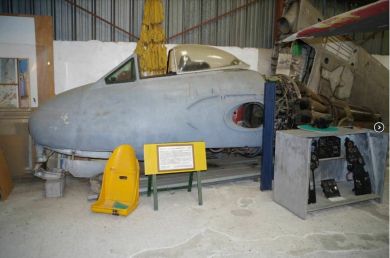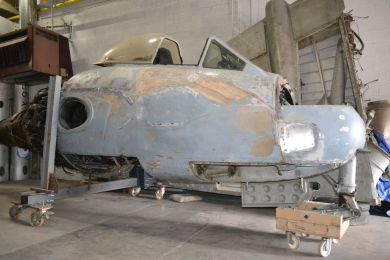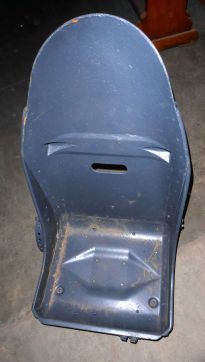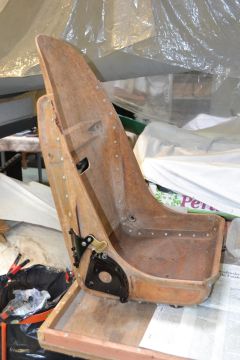

De Havilland dh-100 "Vampire" FB5
The de Havilland DH.100 Vampire was the first jet-powered aircraft anywhere to land on a moving aircraft carrier (this completed in her navalized "Sea Vampire" prototype guise) and she was the first jet aircraft in British service to be powered by a single turbojet engine. In addition, the Vampire became only the second British production military aircraft to be powered solely by jet technology (the Gloster Meteor being the first). Mass-produced too late to see combat during the Second World War, the Vampire will find success throughout the ensuing Cold War years with air forces across Europe, the Middle East and the Far East. The design of the Vampire began as early as 1942. Major Frank Bernard Halford, British aeronautical engineer, had developed his H.1 engine (which was to become the "Goblin" turbojet engine) with enough thrust that a single installation of its type could power an airframe if given a short exhaust jetpipe for maximizing energy output and minimizing thrust loss. Halford's coperation with de Havilland will give birth to the dh-99. After review, the Ministry of Aircraft Production requested the aircraft to feature construction of both wood and metal, which does not pose a problem to de Havilland who already designed and produced aircraft of hybrid construction. This revision created the new designation of "DH.100" in November of 1941. The British authorities ordered a pair of prototypes under the E.6/41 specification and detailed design work began on the new aircraft, then known as the "Spider Crab", in mid-1942. The first flight of a prototype, powered with a Goblin 1 turbojet engine producing a thrust of 2700 pounds, took place on September 20, 1943. Once the evaluations were completed and the dh-100 was accepted into service (under the name of "Vampire"), the production was subcontracted to English Electric. The first serial version, the Vampire Mk 1, was operational in 1946 within the Royal Air Force. The Vampire Mk 1 will quickly be supplanted by the F3 and then by the FB5, designed as a fighter-bomber. This variant will be exported to eleven countries, including France, and built under license in France, Italy and Switzerland. The Vampire was the first jet aircraft used in operation by the French Air Force between 1948 and 1961.
France first receives 30 Vampire Mk1 and 90 Vampire FB5, delivered from December 1948, to which are added 67 FB51 assembled locally by the SNCASE from parts supplied by the United Kingdom, and 120 others entirely built locally with Goblin reactors manufactured by Hispano-Suiza. Subsequently, SNCASE built these aircraft under license under the name SE 535 "Mistral;".
VX 950
A brief history of the VX 950, the last of the Vampire FB5S used by the French air force.
The VX 950 leaves the factory on
17/06/1949 delivered to RAF Manston on 20/06/1949.
12/07/1949 delivered to the French air force
25/09/1953 Ground training and delivery to the Karouba base (Tunisia)
11/09/1953 Naval school
20/01/1954 Naval school of Lanvéoc-Poulmic (Brittany)
1979 Recovered from a ironworker in the 70s, it will be displayed for many years at the Mas Palegry Aircraft Museum in Perpignan after a summary restoration.
Why a Vampire in the collections of the BAPA?
The vampire is an interesting aircraft in more ways than one: one of the first jets, it incorporates both proven and innovative technologies (jet engine). Once restored, it will show how the aircraft was designed taking into account the limitations of the first jet engines. Brilliant design when you consider the number of years the vampire has remained operational!
Arrival of the vampire
The VX 950, offered for sale during the dispersal of the Mas Palegry collection, was finally, after multiple twists and turns, purchased from a French merchant a few days before the Covid confinement. Confinement obliges, it is only a few weeks after that the transport could be organized and that a reduced team took delivery of it. Of small size (well, everything is relative.... ) it will take a good part of the morning to put the machine under cover in the warehouse of our neighbor Yatoo where a storage space is rented.
Status
Mostly complete this aircraft will requie a serious refurbishment, including the repair of the wood cockpit pod and the repairof various components. Some elements that are too damaged will have to be replaced.
Currently stored, some components are being refurbished.
France first receives 30 Vampire Mk1 and 90 Vampire FB5, delivered from December 1948, to which are added 67 FB51 assembled locally by the SNCASE from parts supplied by the United Kingdom, and 120 others entirely built locally with Goblin reactors manufactured by Hispano-Suiza. Subsequently, SNCASE built these aircraft under license under the name SE 535 "Mistral;".
VX 950
A brief history of the VX 950, the last of the Vampire FB5S used by the French air force.
The VX 950 leaves the factory on
17/06/1949 delivered to RAF Manston on 20/06/1949.
12/07/1949 delivered to the French air force
25/09/1953 Ground training and delivery to the Karouba base (Tunisia)
11/09/1953 Naval school
20/01/1954 Naval school of Lanvéoc-Poulmic (Brittany)
1979 Recovered from a ironworker in the 70s, it will be displayed for many years at the Mas Palegry Aircraft Museum in Perpignan after a summary restoration.
Why a Vampire in the collections of the BAPA?
The vampire is an interesting aircraft in more ways than one: one of the first jets, it incorporates both proven and innovative technologies (jet engine). Once restored, it will show how the aircraft was designed taking into account the limitations of the first jet engines. Brilliant design when you consider the number of years the vampire has remained operational!
Arrival of the vampire
The VX 950, offered for sale during the dispersal of the Mas Palegry collection, was finally, after multiple twists and turns, purchased from a French merchant a few days before the Covid confinement. Confinement obliges, it is only a few weeks after that the transport could be organized and that a reduced team took delivery of it. Of small size (well, everything is relative.... ) it will take a good part of the morning to put the machine under cover in the warehouse of our neighbor Yatoo where a storage space is rented.
Status
Mostly complete this aircraft will requie a serious refurbishment, including the repair of the wood cockpit pod and the repairof various components. Some elements that are too damaged will have to be replaced.
Currently stored, some components are being refurbished.


Above: the VX 950 during its operationnal days, the cockpit during its recovery from the scrap dealer and exhibited at the Mas Palegry Aircraft Museum in Perpignan after a summary renovation.







